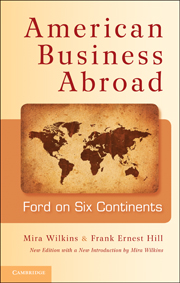Book contents
- Frontmatter
- Contents
- List of Illustrations
- Preface
- Introduction to the New Edition
- Introduction to the First Edition
- 1 First Venture
- 2 Probing for Markets
- 3 Model T: Triumph and Fable
- 4 The Alchemy of War
- 5 Steps in Expansion
- 6 The Sun Never Sets
- 7 Prosperity and Frustration
- 8 The Missionary Spirit
- 9 The Best-Laid Plans
- 10 Marriage of Convenience
- 11 Time of Desperation
- 12 A World Disturbed
- 13 Extreme of Nationalism
- 14 The British Empery
- 15 On Both Sides of World War II
- 16 The Crippled Phoenix
- 17 The New Company
- 18 Manufacturing for World Markets: From Dagenham to Geelong
- 19 New Times, New Faces, New Policies
- Appendices
- Bibliographical Essay
- Notes
- Index
- Titles in the series
- Plate section
12 - A World Disturbed
Published online by Cambridge University Press: 05 June 2012
- Frontmatter
- Contents
- List of Illustrations
- Preface
- Introduction to the New Edition
- Introduction to the First Edition
- 1 First Venture
- 2 Probing for Markets
- 3 Model T: Triumph and Fable
- 4 The Alchemy of War
- 5 Steps in Expansion
- 6 The Sun Never Sets
- 7 Prosperity and Frustration
- 8 The Missionary Spirit
- 9 The Best-Laid Plans
- 10 Marriage of Convenience
- 11 Time of Desperation
- 12 A World Disturbed
- 13 Extreme of Nationalism
- 14 The British Empery
- 15 On Both Sides of World War II
- 16 The Crippled Phoenix
- 17 The New Company
- 18 Manufacturing for World Markets: From Dagenham to Geelong
- 19 New Times, New Faces, New Policies
- Appendices
- Bibliographical Essay
- Notes
- Index
- Titles in the series
- Plate section
Summary
“The urge to industrialize this country has gathered such an impetus that it is incredible that it can be permanently checked,” wrote Benjamin Kopf, manager of the Japanese company, early in 1935. The people “have become so proficient and efficient that today Japan is one of the serious rivals in world commerce.” The motor car and the truck had become necessities. The next step, predicted Kopf, would be manufacture by the Japanese, with measures against imported cars. As the operator of an assembly plant, Ford would be penalized. “The only way for us to retain this important market is to take timely steps to manufacture locally.” Dearborn agreed with him, and Kopf, Frank Riecks, and H. R. Hesser sought a desirable site for a factory in the Yokohama district.
They had been matching stride for stride the Japanese efforts to control the manufacture of motor vehicles in their islands. This urge was one aspect of the sense of national destiny that had been mounting in Japan for a generation. Already victors in wars with China (1895) and Russia (1905), the Japanese had been exhilarated by a sense of achievement and prepared to push along the road to power. As an important step, in September 1931 they seized Manchuria.
This was the first aggression since World War I by a nation that felt itself entitled to larger territories and greater prestige.
- Type
- Chapter
- Information
- American Business AbroadFord on Six Continents, pp. 253 - 269Publisher: Cambridge University PressPrint publication year: 2011

